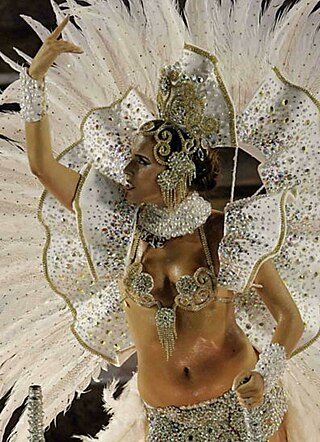
Carnival or Shrovetide is a Christian festive season that occurs before Lent, consisting of Quinquagesima or Shrove Sunday, Shrove Monday, and Shrove Tuesday or Mardi Gras.

The Carnival of Brazil is an annual festival held the Friday afternoon before Ash Wednesday at noon, which marks the beginning of Lent, the forty-day period before Easter. During Lent, Roman Catholics and some other Christians traditionally abstained from the consumption of meat and poultry, hence the term "carnival", from carnelevare, "to remove meat."

A samba school is a dancing, marching, and drumming club. They practice and often perform in a huge square-compounds and are devoted to practicing and exhibiting samba, an Afro-Brazilian dance and drumming style. Although the word "school" is in the name, samba schools do not offer instruction in a formal setting. Samba schools have a strong community basis and are traditionally associated with a particular neighborhood. They are often seen to affirm the cultural validity of the Afro-Brazilian heritage in contrast to the mainstream education system, and have evolved often in contrast to authoritarian development. The phrase "escola de samba" is popularly held to derive from the schoolyard location of the first group's early rehearsals. In Rio de Janeiro especially, they are mostly associated with poor neighborhoods ("favelas"). Samba and the samba school can be deeply interwoven with the daily lives of the shanty-town dwellers. Throughout the year the samba schools have various happenings and events, most important of which are rehearsals for the main event which is the yearly carnival parade. Each of the main schools spend many months each year designing the theme, holding a competition for their song, building the floats and rehearsing. It is overseen by a carnavalesco or carnival director. From 2005, some fourteen of the top samba schools in Rio have used a specially designed warehouse complex, the size of ten football pitches, called Samba City to build and house the elaborate floats. Each school's parade may consist of about 3,000 performers or more, and the preparations, especially producing the many different costumes, provide work for thousands of the poorest in Brazilian society. The resulting competition is a major economic and media event, with tens of thousands in the live audience and screened live to millions across South America.

The Carnival in Rio de Janeiro is a festival held every year before Lent; it is considered the biggest carnival in the world, with two million people per day on the streets. The first Carnival festival in Rio occurred in 1723.

Bahian Carnival is the annual carnival festival celebrated in the Brazilian state of Bahia, mainly in its capital, Salvador. The event officially lasts for six days, beginning on the Thursday before Ash Wednesday and concluding on Ash Wednesday at noon. The term may also be used to comprise related events that happen immediately before or after, extending the duration for up to twelve days.
The Grêmio Recreativo Escola de Samba Acadêmicos do Grande Rio is a samba school of the Special Group of the carnival of the city of Rio de Janeiro, being headquartered on Almirante Barroso street in Duque de Caxias.
The Grêmio Recreativo Escola de Samba União da Ilha do Governador was founded on March 7, 1953 by the friends Maurício Gazelle, and Quincas Orphylo, who were in Cacuia, the main site of the carnival parade of the Ilha do Governador, watching the presentation of small schools of samba and blocks of various districts of the island. It was then decided that the neighborhood of Cacuia should be represented by a samba school. Currently, the school is based in Estrada do Galeão in the neighborhood of Cacuia.
The Grêmio Recreativo Escola de Samba Acadêmicos da Rocinha is a samba school in Rio de Janeiro, located in the neighborhood of São Conrado on Bertha Lutz street.

Grêmio Recreativo Escola de Samba Unidos de Vila Isabel is a samba school in Rio de Janeiro. It was thrice champion of the Special Group and is currently headquartered in Boulevard 28 de Setembro in Vila Isabel.
Marchinha is one of several genres of music typical of Brazilian Carnival in Rio de Janeiro and Southeast Region of Brazil. The other main carnival genres are: samba-enredo, frevo, maracatu and Axé music.
Carnival in Mexico is celebrated by about 225 communities in various ways, with the largest and best known modern celebrations occurring in Mazatlán and the city of Veracruz.

Waldemar Esteves da Cunha was at the time of his death in 2013, the oldest King Momo in Brazil.

Andrea de Andrade is a Brazilian Carnival Queen. She began performing in samba parades in 2006 with Mocidade, a samba school in Rio de Janeiro. In 2010 she won the "Rainha da bateria" of Mocidade and in 2011 led the parade of this school at the Rio de Janeiro carnival.
The Grêmio Recreativo Escola de Samba São Clemente is a samba school from Rio de Janeiro, located in the Cidade Nova neighborhood, on Avenida Presidente Vargas.
The Grêmio Recreativo Escola de Samba Estácio de Sá is one of the most traditional samba schools of the city of Rio de Janeiro. It has won once the top-tier Rio parade in 1992.

The closing ceremony of the 2016 Summer Olympics was held on 21 August 2016 from 20:00 to 22:50 BRT at the Maracanã Stadium, Rio de Janeiro, Brazil.

Elvira Olivieri Cozzolino, better known by her stage name Elvira Pagã, was a Brazilian vedette and actress, singer, writer and painter. She was the first Rio Carnival Queen, the first woman to wear a bikini in public, and one of the first women to have cosmetic surgery in Brazil. Talented and controversial, she broke the status quo and faced the reigning "machismo" with fearless audacity during the Brazilian military dictatorship and the revolutionary 1960s, where she lived with determination and courage. Pagã retired from public life, wrote and painted in her later years, dying a recluse.

Carnival in Goa, also called "Carnaval", "Intruz", "Entrado", or (colloquially) "Viva Carnival" refers to the festival of carnival, in the Indian state of Goa. Though significantly smaller than the well-known Rio Carnival or the Portuguese Carnival of Madeira, the Goa Carnival is the largest in India and one of the few traditional celebrations of the Western Christian holiday in Asia. The current version of the Goa Carnival was modelled after the Rio Carnival by a local musician named Timoteo Fernandes and imposed in 1965 to attract tourists. It has since turned into a major tourist attraction for the small state.

Trilogia dos Carnavais: 25 Anos de Carreira ou de Lápide is a live album by the Brazilian musician Rogério Skylab. It was released on August 30, 2016 through independent label Coqueiro Verde Records, and recorded during a show at the Estúdio 24P in Rio de Janeiro, in which Skylab celebrated 25 years of musical career and promoted his Trilogia dos Carnavais series of albums: Abismo e Carnaval (2012), Melancolia e Carnaval (2014) and Desterro e Carnaval (2015). A DVD containing footage of the performance and additional tracks was simultaneously released. It is Skylab's first of two releases not to be available for free download on his official website, the second being the 2017 EP Skylab. "O que te Perturba" was released as a teaser single on Skylab's YouTube channel on April 24, 2016.












